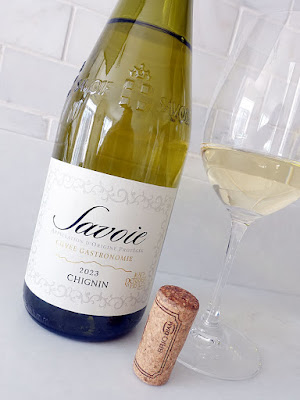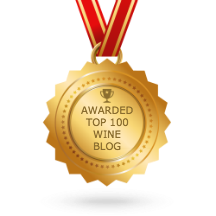white wine review is the latest vintage of a terrific Melon de Bourgogne from the Loire Valley that arrived at the LCBO in last month's LCBO VINTAGES New Release Collection.
It is produced by Domaine Girard, a family estate winery that was established in the 1940s by the husband and wife team of Marcel and Gabrielle Girard in Rebourgère, a hamlet of Maisdon-sur-Sèvre, in the heart of the region of Nantes, Loire Valley. Gaston Girard, the only son of Marcel and Gabrielle, began working on the family farm at an early age and helped his mother, who had lost her husband after he returned from the war with an illness. Like most farms of the period, the Girard family practiced mixed farming with some cattle, cereal crops, and vines.
In 1961, Gaston married Georgette, a young woman from the nearby village of La Haie-Fouassière, and together they grew the farm by giving up on mixed farming and focusing on grapevines. As pioneers in the 1970s, the Girard family focused on direct-selling of their wines. With the entire family involved in the business, Gaston focused on winemaking, while his son, Patrick, helped bottle, label, and wrap the product. At the end of the week, the whole family would travel to other regions in France to hand-deliver their wines to cafés, restaurants, and private clients.
Patrick Girard, the third generation of his family to farm these lands, followed his father's footsteps and began to work in the vineyard and help with winemaking in the late 1980s, after completing his studies in winemaking. In 1991, after Gaston retired, Patrick took over the family estate. In the spring of 1991, the vines froze, and the crop was completely annihilated. In May 1991, Gaston married Martine, and together with bravery and amibition, they rebuilt the family vineyard over the years, while also making numerous improvements using modern techniques both in the vineyard and cellar.
Today, Domaine Girard's philosophy is based on the quality of the work, precision, and the flawless quality of the wines. They have 93 acres of vines in reasoned culture, and use 40% of the crop to create a diverse range of wines. As winemaker, Patrick also works in the vineyard and takes care of the commercial aspects of the business, while Martine works in the cellar, prepares orders, administrative, and accounting activities. The fourth generation of the family, Guillaume Girard, son of Patrick and Martine, joined the family estate in 2013, after completing his studies in winemaking and marketing, and like his father, combines tradition with modernity to craft their lovely Loire Valley wines.
Like the 2022 Domaine Girard Le Fleuron de La Rebourgère Muscadet Sèvre-et-Maine Sur Lie I enjoyed in Spring of last year, this white wine is crafted with 100% Melon de Bourgogne that was grown on silty, clayey, and shallow soils (less than 30 cm), with a sub-soil made of schist and gneiss. The vines are more than 40 years old and planted on weak-to-moderate slopes. The grapes were mechanically harvested, then direct-pressed into underground, thermo-regulated vats for fermentation. The wine was left on its lees for 9–10 months, with one or two bâtonnages (lees stirring) in order to increase richness and texture.
In 2023, the Loire Valley had a challenging vintage due to variable weather conditions which encompassed both rain and heatwaves, with producers fighting against mildew and acid rot. However, one of the most successful areas of the Loire in this vintage was in the western area of Pays Nantais, which encompasses the Muscadet appellations. Because the Melon de Bourgogne varietal is an early ripening grape, producers were able to the Melon grape during the heatwave at the beginning of September, and prior to the heavy rains that fell mid-month. The result was Muscadet with perfectly ripe grapes, very good concentration, and slightly higher alcohol levels. Let's see how this 2023 Muscadet Sèvre-et-Maine from the Loire Valley is tasting tonight...
This 100% Melon de Bourgogne has a medium+ to medium-high intensity nose that is clean and refined with elegant lemon citrus, stone fruit, and ripe apple aromas, plus touches of leesy minerals and a whiff of honey adding nuance and interest. The dry, medium-full bodied palate is rich and densely concentrated with ripe apple, lemon citrus, and leesy mineral flavours, plus stone fruit, melon, and spice characters adding complexity. It has crisp and finely detailed acidity, along with a richly textured mouthfeel. Apple notes give way to leesy and oyster shell minerals with touches of spice on the long, succulent, and juicy finish. Highly recommended buy to enjoy with seafood. Score: 89 pts
Other terrific wines by Domaine Girard can be ordered through their Agent - DBINO David Beauroy Selections.
It is produced by Domaine Girard, a family estate winery that was established in the 1940s by the husband and wife team of Marcel and Gabrielle Girard in Rebourgère, a hamlet of Maisdon-sur-Sèvre, in the heart of the region of Nantes, Loire Valley. Gaston Girard, the only son of Marcel and Gabrielle, began working on the family farm at an early age and helped his mother, who had lost her husband after he returned from the war with an illness. Like most farms of the period, the Girard family practiced mixed farming with some cattle, cereal crops, and vines.
In 1961, Gaston married Georgette, a young woman from the nearby village of La Haie-Fouassière, and together they grew the farm by giving up on mixed farming and focusing on grapevines. As pioneers in the 1970s, the Girard family focused on direct-selling of their wines. With the entire family involved in the business, Gaston focused on winemaking, while his son, Patrick, helped bottle, label, and wrap the product. At the end of the week, the whole family would travel to other regions in France to hand-deliver their wines to cafés, restaurants, and private clients.
Patrick Girard, the third generation of his family to farm these lands, followed his father's footsteps and began to work in the vineyard and help with winemaking in the late 1980s, after completing his studies in winemaking. In 1991, after Gaston retired, Patrick took over the family estate. In the spring of 1991, the vines froze, and the crop was completely annihilated. In May 1991, Gaston married Martine, and together with bravery and amibition, they rebuilt the family vineyard over the years, while also making numerous improvements using modern techniques both in the vineyard and cellar.
Today, Domaine Girard's philosophy is based on the quality of the work, precision, and the flawless quality of the wines. They have 93 acres of vines in reasoned culture, and use 40% of the crop to create a diverse range of wines. As winemaker, Patrick also works in the vineyard and takes care of the commercial aspects of the business, while Martine works in the cellar, prepares orders, administrative, and accounting activities. The fourth generation of the family, Guillaume Girard, son of Patrick and Martine, joined the family estate in 2013, after completing his studies in winemaking and marketing, and like his father, combines tradition with modernity to craft their lovely Loire Valley wines.
Like the 2022 Domaine Girard Le Fleuron de La Rebourgère Muscadet Sèvre-et-Maine Sur Lie I enjoyed in Spring of last year, this white wine is crafted with 100% Melon de Bourgogne that was grown on silty, clayey, and shallow soils (less than 30 cm), with a sub-soil made of schist and gneiss. The vines are more than 40 years old and planted on weak-to-moderate slopes. The grapes were mechanically harvested, then direct-pressed into underground, thermo-regulated vats for fermentation. The wine was left on its lees for 9–10 months, with one or two bâtonnages (lees stirring) in order to increase richness and texture.
In 2023, the Loire Valley had a challenging vintage due to variable weather conditions which encompassed both rain and heatwaves, with producers fighting against mildew and acid rot. However, one of the most successful areas of the Loire in this vintage was in the western area of Pays Nantais, which encompasses the Muscadet appellations. Because the Melon de Bourgogne varietal is an early ripening grape, producers were able to the Melon grape during the heatwave at the beginning of September, and prior to the heavy rains that fell mid-month. The result was Muscadet with perfectly ripe grapes, very good concentration, and slightly higher alcohol levels. Let's see how this 2023 Muscadet Sèvre-et-Maine from the Loire Valley is tasting tonight...
Tasting Note:
FLEURON DE LA REBOURGÈRE SUR LIE MUSCADET SÈVRE-ET-MAINE 2023 - AOC, Loire, France (#557207) (XD) - $16.95This 100% Melon de Bourgogne has a medium+ to medium-high intensity nose that is clean and refined with elegant lemon citrus, stone fruit, and ripe apple aromas, plus touches of leesy minerals and a whiff of honey adding nuance and interest. The dry, medium-full bodied palate is rich and densely concentrated with ripe apple, lemon citrus, and leesy mineral flavours, plus stone fruit, melon, and spice characters adding complexity. It has crisp and finely detailed acidity, along with a richly textured mouthfeel. Apple notes give way to leesy and oyster shell minerals with touches of spice on the long, succulent, and juicy finish. Highly recommended buy to enjoy with seafood. Score: 89 pts
Other terrific wines by Domaine Girard can be ordered through their Agent - DBINO David Beauroy Selections.



































